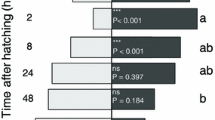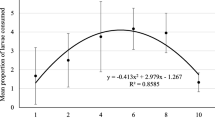We examined the effect of prey (Tetranychus urticae) egg density on leaving rate of the predatory mite, Phytoseiulus persimilis, from leaf disks using predators with different feeding experiences and levels of external volatile cues related to their prey. Predators stayed longer on disks with prey eggs than on those without prey eggs. However, at each prey egg density predators stayed longer in the absence of prey-related volatiles from an external source. Starved predators stayed longer in a prey patch than those that had not experienced starvation. At each prey density, starved P. persimilis consumed a greater proportion of prey eggs than satiated predators. The total prey consumption of starved predators appears to be related to their longer residence time on source disks compared to satiated predators and also the per capita consumption rate was greater for starved predators compared to satiated predators.


Similar content being viewed by others

REFERENCES
Bernstein, C. (1983). Some aspects of Phytoseiulus persimilis (Acarina: Phytoseiidae) dispersal behavior. Entomophaga 28: 185–198.
Bernstein, C. (1984). Prey and predator emigration responses in the acarine system Phytoseiulus persimilis-Tetranychus urticae. Oecologia 61: 134–142.
Dicke, M., van Beek, T. A., Posthumus, M. A., Ben Dom, N., van Bokhoven, H., and de Groot, A. E. (1990a). Isolation and identification of volatile kairomone that affects acarine predator-prey interactions: involvement of host plant in its production. J. Chem. Ecol. 16: 381–396.
Dicke, M., Sabelis, M. W., Takabayashi, J., Bruin, J., and Posthumus, M. A. (1990b). Plant strategies of manipulating predator-prey interactions through allelochemicals: prospects for application in pest control. J. Chem. Ecol. 16: 3091–3118.
Eveleigh, E. S., and Chant, D. A. (1982). Experimental studies on acarine predator-prey interactions: The response of predators to prey distribution in a homogeneous area (Acarina: Phytoseiidae). Can. J. Zool. 60: 639–647.
Fernando, M. H. J. P., and Hassell, M. P. (1980). Predator-prey responses in acarine system. Researches on Pop. Ecol. 22: 301–322.
Hopper, K. R., Roush, R. T., and Powell, W. (1993). Management of genetics of biological-control introductions. Ann. Rev. Entomol. 38: 27–51.
Janssen, A. (1999). Plants with spider-mite prey attract more predatory mites than clean plants under greenhouse conditions. Entomol. Exp. Appl. 90: 191–198.
Janssen, A., Bruin, J., Jacobs, G., Schraag, R., and Sabelis, M. W. (1997). Predators use volatiles to avoid prey patches with conspecifics. J. Animal Ecol. 66: 223–232.
Jia, F., Margolies, D. C., Boyer, J. E. Jr., and Charlton, R. E. (2002). Genetic variation among foraging traits in inbred lines of a predatory mite. Heredity 88: 371–379.
Lewis, W. J., and Martin, W. R. Jr. (1990). Semiochemicals for use with parasitoids: Status and future. J. Chem. Ecol. 16: 3067–3089.
Lewis, W. J., Vet, L. E. M., Tumlinson, J. H., van Lenteren, J. C., and Papaj, D. R. (1990). Variations in parasitoid foraging behavior: Essential element of a sound biological control theory. Environ. Entomol. 19: 1183–1193.
Maeda, T., Takabayashi, J., Yano, S., and Takafuji, A. (1998). Factors affecting the resident time of the predatory mite Phytoseiulus persimilis (Acari: Phytoseiidae) in a prey patch. Appl. Entomol. Zool. 33: 573–576.
Maeda, T., and Takabayashi, J. (2001). Patch leaving decision of the predatory mite Amblyseius womersleyi (Acari: Phytoseiidae) based on multiple signals form both inside and outside a prey patch. J. Insect Behav. 14: 829–839.
Maeda, T., and Takabayashi, J. (2005). Effect of foraging experiences on residence time of the predatory mite Neoseiulus womersleyi in a prey patch. J. Insect Behav. 18: 323–333.
Margolies, D. C., Boyer, J. E. Jr., Sabelis, M. W. (1997). Response of a phytoseiid predator to herbivore-induced plant volatiles: selection on attraction and effect on prey exploitation. J. Insect Behav. 10: 715–729.
Mayland, H. J. (1998). Effects of prey-induced plant volatiles on search behaviors of the predatory mite, Phytoseiulus persimilis. M.S. Thesis, Kansas State University, Manhattan, KS, p. 63.
Mayland, H., Margolies, D. C., and Charlton, R. E. (2000). Local and distant prey-related cues influence when an acarine predator leaves a patch. Entomol. Exp. Appl. 96: 245–252.
Pels, B., de Roos, A. M., and Sabelis, M. W. (2002). Evolutionary dynamics of prey exploitation in a metapopulation of predators. Am. Nat. 159: 172–189.
Sabelis, M. W., Vermaat, J. E., and Groeneveld, A. (1984). Arrestment responses of the predatory mite, Phytoseiulus persimilis, to steep odour gradients of kairomones. Physiol. Entomol. 9: 437–446.
Sabelis, M. W., and Afman, B. P. (1994). Synomone—induced suppression of take-off in the phytoseiid mite, Phytoseiulus persimilis Athias-Henriot. Exp. Appl. Acarol. 18: 711–721.
Sabelis, M. W., and Dicke, M. (1985). Long-range dispersal and searching behavior. In Helle, W. and Sabelis, M. W. (eds.), Spider Mites: Their Biology, Natural Enemies and Control, Elsevier, Amsterdam, pp. 141–159.
Sabelis, M. W., and Van Der Meer, J. J. (1986). Local dynamics of the interaction between predatory mites and two-spotted spider mites. In Metz, J. A. J., and Diekmann, O. (eds.), Dynamics of Physiologically Structured Populations, Springer, Berlin, pp. 322–344.
Sabelis, M. W., and Van Der Weel, J. J. (1993). Anemotactic responses of the predatory mite, Phytoseiulus persimilis Athias-Henriot and their role in prey finding. Exp. Appl Acarol. 17: 521–529.
SAS Institute (2001). SAS user’s guide: statistics, version 8.2 SAS Institute, Cary NC.
Stephens, D. W., and Krebs, J. R. (1986). Foraging theory, Princeton University Press, Princeton, NJ, p. 247.
Takafuji, A. (1977). The effect of the rate of successful dispersal of a phytoseiid mite, Phytoseiulus persimilis Athias-Henriot (Acarina: Phytoseiidae) on the persistence in the interactive system between the predator and its prey. Res. Popul. Ecol. 18: 210–222.
Takafuji, A., and Chant, D. A. (1976). Comparative studies of two species of predacious phytoseiid mites (Acarina: Phytoseiidae), with special reference to their response to the density of their prey. Res. Popul. Ecol. 17: 255–310.
Takafuji, A., Tsuda, Y., and Mori, T. (1983). System behaviour in predator-prey interaction, with special reference to acarine predator-prey systems. Res. Popul. Ecol. Suppl. 3: 75–92.
Tumlinson, J. H. (1988). Contemporary frontiers in insect semiochemical research. J. Chem. Ecol. 14: 2109–2130.
van Lenteren, J. C., and Woets, J. (1988). Biological and integrated pest control in greenhouses. Ann. Rev. Entomol. 33: 239–269.
Vanas, V., Enigl, E., Walzer, A., and Schausberger, P. (2006). The predatory mite Phytoseiulus persimilis adjusts patch-leaving to own and progeny needs. Exp. Appl. Acarol. 39: 1–11.
Vet, L. E. M., and Dicke, M. (1992). Ecology of infochemical use by natural enemies in a tritrophic context. Ann. Rev. Entomol. 37: 141–172.
Waage, J. K. (1979). Foraging for patchily-distributed hosts by the parasitoid. Nemeritis canescens. J. Anim. Ecol. 48: 353–371.
Zhang, Z.-Q., Sanderson, J. P., and Nyrop, J. P. (1992). Foraging time and spatial patterns of predation in experimental populations. Oecologia. 90: 185–196.
Zemek, R., and Nachman, G. (1998). Interactions in a tritrophic acarine predator-prey metapopulation system: prey location and distance moved by Phytoseiulus persimilis (Acarina: Phytoseiidae). Exp. Appl. Acarol. 22: 259–278.
ACKNOWLEDGMENTS
We thank Xiaoli Wu and Nick Timmons for their assistance in conducting the research, and Anthony Joerns for comments on an earlier draft of this paper. This is Contribution No. 06-267-J from the Kansas Agricultural Experiment Station.
Author information
Authors and Affiliations
Corresponding author
Rights and permissions
About this article
Cite this article
Nachappa, P., Margolies, D.C. & Nechols, J.R. Resource-Dependent Giving-Up Time of the Predatory Mite, Phytoseiulus persimilis . J Insect Behav 19, 741–752 (2006). https://doi.org/10.1007/s10905-006-9059-7
Published:
Issue Date:
DOI: https://doi.org/10.1007/s10905-006-9059-7



